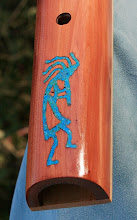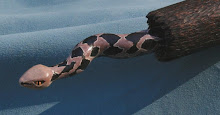New 'kids' in the making!...
Just some pics of flutes I've recently taken to the hexagonal stage for further voicing and finishing...
(click on pics to enlarge)

First is a group of open-end flutes that are right at the key of G. The Walnut has a bird beak end and by the looks of the figuring will be gorgeous when sanded down to 1000 grit! The Ambrosia will have one larger tuning hole cut on the bottomside of the flute, while the Yellowheart has the more traditional 4 tuning holes around the flute. The Black Limba is a wonderful compact 'standard' flute. FYI, I almost always make my blocks last and don't know what I'll make for each flute until I get to it. The Black Limba may look snazzy with couple of turquoise bands...and the Ambrosia and Yellowheart will have added length at the foot ends, which would be good for some inlay.
 Next is a trio of 7/8" bore closed-end flutes that will key out in the G-A# range, more than likely. My closed-ends usually pitch a little higher than open-end counterparts, for some reason. Each flute has a solid rectangular foot for carving 'stuff'...I'm pretty sure I'm going to use the Ambrosia one for a special carving of a Downy or Hairy Woodpecker...closed-end flutes are truly unique, but they are labor-intensive!
Next is a trio of 7/8" bore closed-end flutes that will key out in the G-A# range, more than likely. My closed-ends usually pitch a little higher than open-end counterparts, for some reason. Each flute has a solid rectangular foot for carving 'stuff'...I'm pretty sure I'm going to use the Ambrosia one for a special carving of a Downy or Hairy Woodpecker...closed-end flutes are truly unique, but they are labor-intensive!
 Above is a group of flat-bottomed "Half-Pipes" of mine that will be fairly high in pitch. The Aspen neck flute will probably be a high F# or G...not sure where the Makores will fall, but they'll be lower than that. Note that all the Makores are the same length in the playing barrel (going left)...they differ in the lengths of their slow-air chambers (SACs). Makore is a wonderful tone wood, and I imagine these will be quick, lively players.
Above is a group of flat-bottomed "Half-Pipes" of mine that will be fairly high in pitch. The Aspen neck flute will probably be a high F# or G...not sure where the Makores will fall, but they'll be lower than that. Note that all the Makores are the same length in the playing barrel (going left)...they differ in the lengths of their slow-air chambers (SACs). Makore is a wonderful tone wood, and I imagine these will be quick, lively players.
 These are 2 slightly larger flutes...the quartersawn Sycamore is a special order flute...nice lightweight wood with great marbling. Papua New Guinea Walnut has a gorgeous light tan luster, and is a fairly lightweight wood, itself. When it's finished, you just twist it in the light and it really glows. I added some detail pics of the spalting below:
These are 2 slightly larger flutes...the quartersawn Sycamore is a special order flute...nice lightweight wood with great marbling. Papua New Guinea Walnut has a gorgeous light tan luster, and is a fairly lightweight wood, itself. When it's finished, you just twist it in the light and it really glows. I added some detail pics of the spalting below:

For you inquiring minds, you can read more about spalting (caused by fungus) by clicking on it's fancier scientific term:
intraspecific antagonism
-----------------------------------
As always, stay tuned for more!
Just some pics of flutes I've recently taken to the hexagonal stage for further voicing and finishing...
(click on pics to enlarge)

First is a group of open-end flutes that are right at the key of G. The Walnut has a bird beak end and by the looks of the figuring will be gorgeous when sanded down to 1000 grit! The Ambrosia will have one larger tuning hole cut on the bottomside of the flute, while the Yellowheart has the more traditional 4 tuning holes around the flute. The Black Limba is a wonderful compact 'standard' flute. FYI, I almost always make my blocks last and don't know what I'll make for each flute until I get to it. The Black Limba may look snazzy with couple of turquoise bands...and the Ambrosia and Yellowheart will have added length at the foot ends, which would be good for some inlay.
 Next is a trio of 7/8" bore closed-end flutes that will key out in the G-A# range, more than likely. My closed-ends usually pitch a little higher than open-end counterparts, for some reason. Each flute has a solid rectangular foot for carving 'stuff'...I'm pretty sure I'm going to use the Ambrosia one for a special carving of a Downy or Hairy Woodpecker...closed-end flutes are truly unique, but they are labor-intensive!
Next is a trio of 7/8" bore closed-end flutes that will key out in the G-A# range, more than likely. My closed-ends usually pitch a little higher than open-end counterparts, for some reason. Each flute has a solid rectangular foot for carving 'stuff'...I'm pretty sure I'm going to use the Ambrosia one for a special carving of a Downy or Hairy Woodpecker...closed-end flutes are truly unique, but they are labor-intensive! Above is a group of flat-bottomed "Half-Pipes" of mine that will be fairly high in pitch. The Aspen neck flute will probably be a high F# or G...not sure where the Makores will fall, but they'll be lower than that. Note that all the Makores are the same length in the playing barrel (going left)...they differ in the lengths of their slow-air chambers (SACs). Makore is a wonderful tone wood, and I imagine these will be quick, lively players.
Above is a group of flat-bottomed "Half-Pipes" of mine that will be fairly high in pitch. The Aspen neck flute will probably be a high F# or G...not sure where the Makores will fall, but they'll be lower than that. Note that all the Makores are the same length in the playing barrel (going left)...they differ in the lengths of their slow-air chambers (SACs). Makore is a wonderful tone wood, and I imagine these will be quick, lively players. These are 2 slightly larger flutes...the quartersawn Sycamore is a special order flute...nice lightweight wood with great marbling. Papua New Guinea Walnut has a gorgeous light tan luster, and is a fairly lightweight wood, itself. When it's finished, you just twist it in the light and it really glows. I added some detail pics of the spalting below:
These are 2 slightly larger flutes...the quartersawn Sycamore is a special order flute...nice lightweight wood with great marbling. Papua New Guinea Walnut has a gorgeous light tan luster, and is a fairly lightweight wood, itself. When it's finished, you just twist it in the light and it really glows. I added some detail pics of the spalting below:
For you inquiring minds, you can read more about spalting (caused by fungus) by clicking on it's fancier scientific term:
intraspecific antagonism
-----------------------------------
As always, stay tuned for more!





No comments:
Post a Comment